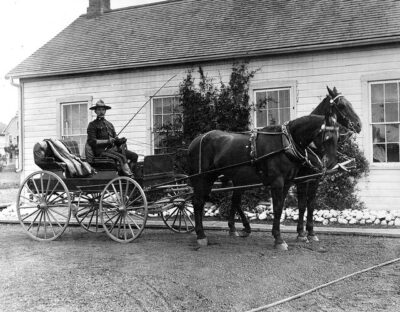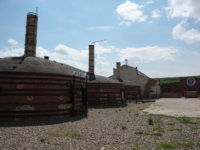Departure marks end of an era for Mounties in Lethbridge
By Al Beeber - Lethbridge Herald on November 20, 2021.
 Galt Museum & Archives 20071043002-007 -
A member of the Mounted Police sits in a horse-drawn buggy on the barracks square in Lethbridge in the early 1900s.
Galt Museum & Archives 20071043002-007 -
A member of the Mounted Police sits in a horse-drawn buggy on the barracks square in Lethbridge in the early 1900s.LETHBRIDGE HERALDabeeber@lethbridgeherald.com
The departure of the RCMP from Lethbridge to Coaldale this year marks the end of a storied history for the national police force in the city.
Area historian and artist George Kush knows that history well. Kush gave a lecture about the RCMP in Lethbridge at the Galt Museum this week.
That history dates back 136 years in 1885 when the city’s first detachment was established overlooking the Oldman River near the site where the Galt Museum & Archives now stands, said Kush. The Mounties later that year took over an abandoned butcher shop on 2 Avenue and converted it to a jail, building cells in the back of the building.
“They started off on the bluffs overlooking the Oldman River, right where the Galt Museum is. They established their first camp there in 1885, then they rented or just took over an abandoned butcher shop on Second Avenue not far from the camp on the bluffs. And then they converted that old butcher shop into a sort of a jail. They put some cells in the back and had a little office in front and arrested drunks, and threw them in there,” said Kush, who is a former longtime president of the Lethbridge Historical Society.
On Aug. 1, 1885, Corporal Eli Hodder and five men arrived from Fort Macleod and set up a camp “under canvas” and moved to the butcher shop before winter.
Much of the art Kush creates is historical in nature and “if you’re interested in the history of the Canadian West, especially Alberta, you kind of have to have an interest in the mounted police, too, and the role they played in founding the province, so to speak. I also have interests in the Indigenous history,” said Kush, a member of the Blood Headress Society, a veterans’ society on the reserve.
Every Saturday, a police magistrate would come from Fort Macleod to dispense the “Queen’s Justice,” he said. Anyone not employed was considered to be a vagrant and jailed. After paying a fine, they had to find work or leave Lethbridge.
On July 12, 1886, the Canadian government purchased 12 acres of land between 4 and 6 Avenues from the North Western Coal and Navigation Company founded by Sir Alexander Tilloch Galt in 1882 and managed by his son Elliott Torrance Galt.
The property was purchased for $4,000, lower than the $7,000 that the mining company wanted, Kush said Thursday. Construction started in October of that year and Lethbridge became headquarters for K Division in June 1887.
In March 1932, K Division headquarters were moved to Edmonton where they remain today, he said.
Tenders were taken for construction for those first barracks and the same company that built the barracks in Fort Macleod in 1884 won the contract. That company built a series of buildings on those 12 acres including stables, officers’ quarters, a guard house, barracks, quartermaster stores and hospital, he said.
“It was quite an elaborate complex,” Kush said.
One remnant of those original barracks still standing – the only one Kush is aware of – is the Sea Cadet headquarters located near the Chinook Regional Hospital. It was moved in 1946 from the barracks square to its present location.
“The big job was to stamp out the illegal use of alcohol because there was Prohibition in the Northwest Territories at that time and of course, you get a mining town with a lot of miners and transient population and they’re gonna bring liquor in any possible way they can do it. And the police were primarily sent to Lethbridge to control the liquor trade in the community and also sort of keep the prostitution” controlled, he said of the Mounties’ initial role here.
“The Red Light District was actually right over by where the mines were,” Kush said.
“There must have been at least a dozen or more saloons. It seems like a saloon was opening every week and usually it was just a little shack kind of thing where guys would get together and drink until they were falling down drunk,” he said.
“They were controlling the liquor and the prostitution. There wasn’t much else to do except enforce the Customs laws, he said.
The police, however, drank almost as much as civilians, Kush said, but they managed to secure alcohol because the Mounties also acted as the post office. They managed to get alcohol to the city by locking it in mailbags and opening it here with a key, he said.
“They controlled the mail and that’s how the Mounties brought their own liquor in. Because of Prohibition, the mail in the early days would arrive in mail sacks and only the police had keys to the mail sacks. So they would make sure the booze went into the mail sacks at one end and they were at the other end to open the mail sacks and that’s how they got their booze,” Kush said.
Somewhere on that property to this day is buried the remains of a miner named Wasyl Chobator who was executed on Jan. 14, 1911 for killing another man, Kush said.
Gallows were built in the No. 1 stable and the man was hung. A hole was dug underneath, his body thrown in and covered with quick lime, he said.
Also buried on the property where the Civic Centre, City Hall and LSCO reside are obsolete live munitions and obsolete weapons that were disposed of in the 1940s, Kush said.
“They buried it in pits and one of the old-timers, about 35 years ago, took me there and drew a map and said this is where they dug the pits and this is where they buried the stuff.”
That work was done in the 1940s when the barracks block square was decommissioned around the start of the Second World War and the buildings were all sold to the City of Lethbridge and the city started tearing everything down, Kush said.
In January 1956, the Lethbridge Subdivision opened at a cost of $319,000 with opening ceremonies held in a garage as temperatures plummeted to -40, Kush said.
Follow @albeebHerald on Twitter
4-3



